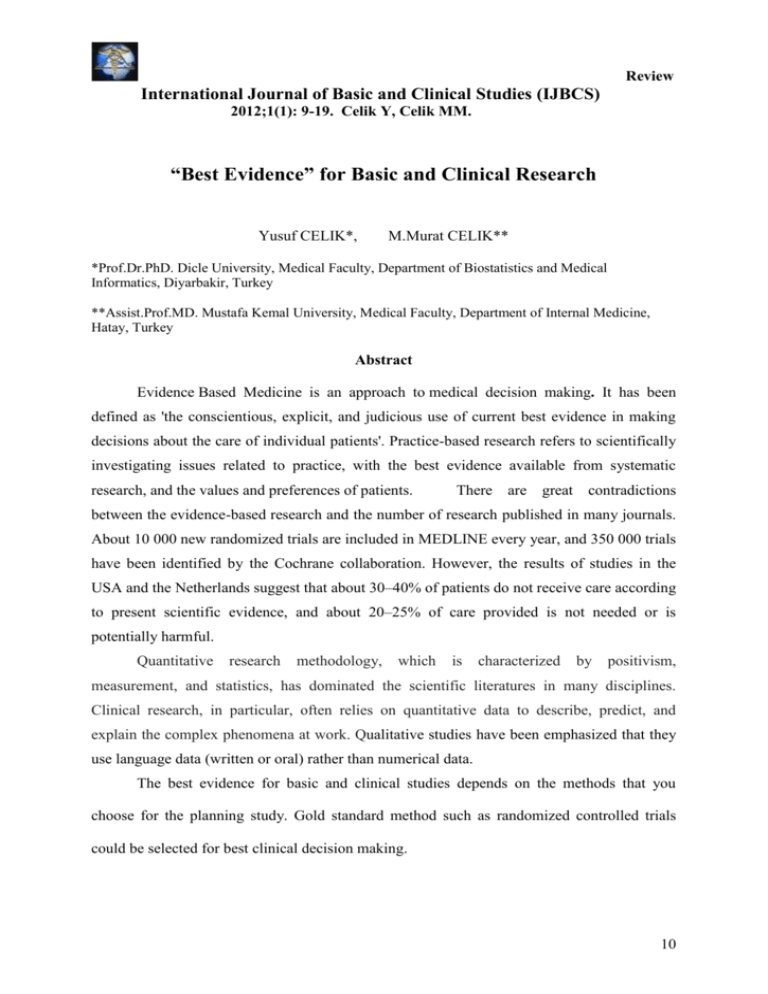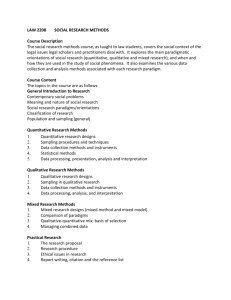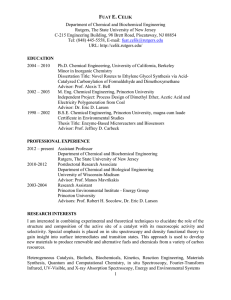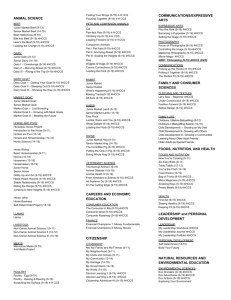Best evidence method for basic and clinical research
advertisement

Review International Journal of Basic and Clinical Studies (IJBCS) 2012;1(1): 9-19. Celik Y, Celik MM. “Best Evidence” for Basic and Clinical Research Yusuf CELIK*, M.Murat CELIK** *Prof.Dr.PhD. Dicle University, Medical Faculty, Department of Biostatistics and Medical Informatics, Diyarbakir, Turkey **Assist.Prof.MD. Mustafa Kemal University, Medical Faculty, Department of Internal Medicine, Hatay, Turkey Abstract Evidence Based Medicine is an approach to medical decision making. It has been defined as 'the conscientious, explicit, and judicious use of current best evidence in making decisions about the care of individual patients'. Practice-based research refers to scientifically investigating issues related to practice, with the best evidence available from systematic research, and the values and preferences of patients. There are great contradictions between the evidence-based research and the number of research published in many journals. About 10 000 new randomized trials are included in MEDLINE every year, and 350 000 trials have been identified by the Cochrane collaboration. However, the results of studies in the USA and the Netherlands suggest that about 30–40% of patients do not receive care according to present scientific evidence, and about 20–25% of care provided is not needed or is potentially harmful. Quantitative research methodology, which is characterized by positivism, measurement, and statistics, has dominated the scientific literatures in many disciplines. Clinical research, in particular, often relies on quantitative data to describe, predict, and explain the complex phenomena at work. Qualitative studies have been emphasized that they use language data (written or oral) rather than numerical data. The best evidence for basic and clinical studies depends on the methods that you choose for the planning study. Gold standard method such as randomized controlled trials could be selected for best clinical decision making. 10 Review International Journal of Basic and Clinical Studies (IJBCS) Key words: 2012;1(1): 9-19. Celik Y, Celik MM. Best evidence, Evidence-based practice, best research design, Quantitative research, Qualitative research Introduction The phrase 'evidence-based medicine' originated in the 1980s as a way of describing the problem-based learning approach initiated at McMaster University medical school. 'Evidence-based practice' and 'evidence-based health care' are phrases that have since been used to represent the concepts and principles encompassed by evidence-based medicine, but are applicable to the broader health care context. Evidence-based practice has been defined as 'the conscientious, explicit, and judicious use of current best evidence in making decisions about the care of individual patients'. Practice-based research refers to scientifically investigating issues related to practice, with the best evidence available from systematic research, and the values and preferences of patients (1). Evidence-based medicine (EBM) is the integration of best research evidence with clinical expertise and patient values. It aims to apply the best available evidence gained from the scientific method to medical decision making and it seeks to assess the quality of evidence of the risks and benefits of treatments (2). Most, but not all, health practitioners (including physicians, nurses, occupational and physical therapists, and psychologists) are taught that the scientific method is the most appropriate method of deciding on what treatment to apply to each patient. The appropriate use of best evidence meta-analysis should play a part in the integration of scientific researches and making reasonable outcomes. Best evidence meta-analysis is part of the solution, not part of the problem (3). 11 Review International Journal of Basic and Clinical Studies (IJBCS) 2012;1(1): 9-19. Celik Y, Celik MM. There are great contradictions between the evidence-based research and the number of research all over the world. About 10 000 new randomized trials are included in MEDLINE every year, and 350 000 trials have been identified by the Cochrane collaboration. However, the results of studies in the USA and the Netherlands suggest that about 30–40% of patients do not receive care according to present scientific evidence, and about 20–25% of care provided is not needed or is potentially harmful (4). Pyramid of Evidence The first step before tracking down the best evidence in scientific data bases is to develop an answerable question. A technique has been advocated in human medicine based on PICO and PECOT principles. ‘P’ is for ‘patient’ or ‘problem’; the query should refer to the population to which the patient belongs and to the primary problem. ‘I’ (or ‘E’) is for ‘intervention’ (or ‘exposures’). This is important to guide the choice of appropriate study design, since some methods are more adequate than others to answer to specific questions (Table 1). The intervention could be a diagnosis, therapeutic intervention, prognostic factor or exposure. ‘C’is for the ‘control’ group. It defines the alternative; it may be one treatment vs. another treatment or the absence of treatment. It is sometimes useful to consider ‘doing nothing’ as an alternative. ‘O’ is for clinical ‘outcome’, which is what the clinician hopes to accomplish, measure, improve or affect. The ‘time’ frame (‘T’) during which the outcome is expected to occur is sometimes included in the question. Although this technique may appear to be awkward, clinicians who use the PICO and PECOT systems are able to identify concepts and descriptors (key words) that allow literature data bases to be searched more effectively for quality papers (5-7). 12 Review International Journal of Basic and Clinical Studies (IJBCS) 2012;1(1): 9-19. Celik Y, Celik MM. Figure 1 summaries the levels of evidence in a pyramid designed to help the clinician to order the commonly applied study designs by level of evidence. Studies towards the top of the pyramid are ‘stronger’ because the design of these studies limits possible biases (systematic error) and adequate statistical analysis is performed, thus limiting random error. Further categorized the levels of evidence have been developed. Class A evidence is the ‘best’ and is derived from randomized, double-blind, placebo-controlled clinical trials. Class B evidence is derived from high quality clinical trials utilizing historical controls and class C evidence is from uncontrolled case series. The least reliable is class D evidence, which is derived from anecdotal clinical reports or expert opinion, or extrapolated from bench top experiments. More elaborate and complex classifications are sometimes used in systematic reviews. The top level of evidence consists of meta-analyses of randomised controlled trials, i.e. a process of synthesising research results by using various statistical methods to retrieve, select and combine results from previous separate but related studies (5,8,9). 13 Review International Journal of Basic and Clinical Studies (IJBCS) 2012;1(1): 9-19. Celik Y, Celik MM. Figure 1. Pyramid of evidence by Vandeweerd JM et all. (5) According Rosner AL, evidence-based medicine (EBM) is beset with numerous problems. In addition to the fact that varied audiences have each customarily sought differing types of evidence, EBM traditionally incorporated a hierarchy of clinical research designs, placing systematic reviews and meta-analyses at the pinnacle. However the accuracy depends on the quality of the randomised controlled trials included in the meta-analysis. Because randomised controlled trials are the gold standard for clinical decision making. Different study designs are considered in the context of a pyramid of evidence, Yet the canonical pyramid of EBM excludes numerous sources of research information, such as basic research, epidemiology, and health services research (10). The power of the evidence-based approach can be enhanced by the development of techniques such as systematic review and Meta analysis. Both studies often have increased power and decreased bias as compared with the individual studies they include. However, although EBM allows us to use current best evidence to make decisions about patient care, the evidence gained from systematic review and meta-analysis only applies to an ‘‘average patient’’ and is not readily adaptable to issues such as etiology, diagnosis and prognosis (11). 14 Review International Journal of Basic and Clinical Studies (IJBCS) 2012;1(1): 9-19. Celik Y, Celik MM. The purpose of a research design is to provide a plan of study that permits accurate assessment of cause and effect relationships among variables. Randomized controlled trials are one of the least biased sources of clinical research evidence and also provide good estimates of treatment effects but not of overall prognosis. Comprehensive non-randomized cohort studies with long-term follow-up, however, might help to answer this question. Thus, the core issue at this stage is the ability to focus the problem and convert it into a question for the identification of the appropriate type of research design that provides the most accurate and unbiased information that could help in its resolution. Table 2 presents examples of everyday questions and links them to the suggested research designs for their resolution (12). Table 2*. Examples of research designs for different clinical questions. Possible questions What is the best treatment/intervention? Primary studies Therapy Is this treatment/intervention better than the other(s)? Would this treatment/intervention prevent or cure the disease in this specific patient? How good is this test/method to detect the condition? Should I order this test/method to detect the condition? Research design RCTs Systematic reviews of RCTs Diagnosis Cross-sectional studies Harm Case–control studies, cohort studies Does this exposure increase the risk of disease? What is the probability of death (or any outcome such as recurrence, etc.) for this condition? What is the probability of developing the disease/ outcome in the presence of this condition/symptom? Prognosis Cohort studies Which is the best treatment/diagnostic procedure, taking into account costs and outcomes? Is this treatment/diagnostic procedure more cost-effective than the alternative? Economic evaluation Studies containing costbenefit analysis, or costeffectiveness analysis, or cost-utility analysis How can I interpret the results of this test/method? What are the consequences of this intervention/ exposure? RCT, randomized controlled trial. * Abalos E et all. 15 Review International Journal of Basic and Clinical Studies (IJBCS) 2012;1(1): 9-19. Celik Y, Celik MM. Evidence for Assessing Quantitative and Qualitative Health Research There are two broad research paradigms: quantitative and qualitative. Most biomedical studies are quantitative; that is, numerical data is collected and analyzed. However, numbers and statistics are not always the most appropriate approach to a clinical research question. Where research questions pertain to subjective phenomena such as feelings, attitudes and emotional responses, a qualitative research paradigm should be used. Qualitative research emphasizes in-depth exploration and description, rather than numerical measurement, of variables. This results in a rich and deep understanding of the topic under study. Qualitative and quantitative research paradigms have distinct methodological underpinnings that influence every aspect of study conduct including sampling, data collection and data analysis. It is therefore critical to match the research paradigm to the clinical research question prior to more in-depth consideration of study design (as described below) to ensure that the eventual study results are valid and useful. Such considerations apply to both primary and secondary (literature review) research. Table 3 summarizes key differences between qualitative and quantitative research approaches using two clinical research questions described earlier. An in-depth description of these differences is beyond the scope of this paper (13). 16 Review International Journal of Basic and Clinical Studies (IJBCS) 2012;1(1): 9-19. Celik Y, Celik MM. Quantitative research methodology, which is characterized by positivism, measurement, and statistics, has dominated the scientific literatures in many disciplines. Quantitative research is, as the term suggests, concerned with the collection and analysis of data in numeric form. Qualitative Research on the other hand generates non-numerical data. Clinical research, in particular, often relies on quantitative data to describe, predict, and explain the complex phenomena at work. In fact, all too often, researchers associate “quantitative research” with “statistics,” failing to realize that a lot needs to happen before a statistical procedure can be applied to analyze the data. Without a rigorous research design, a sound sampling scheme, a reliable and valid instrument, and a meticulous data cleaning mechanism in place, no sophisticated statistic procedures can evade the Garbage In, Garbage Out fallacy (14). Many qualitative studies aim to understand social situations from the point(s) of view of those involved, whether they are the people receiving health services or the professionals delivering them. It has been also emphasized that qualitative research uses language data (written or oral) rather than numerical data. A genuinely qualitative study will employ qualitative methods of data collection and analysis (such as in-depth interviews rather than questionnaires), and will also present qualitative data (such as verbal data rather than numerical data). Thus for example, a study which collected qualitative data using semi- 17 Review International Journal of Basic and Clinical Studies (IJBCS) 2012;1(1): 9-19. Celik Y, Celik MM. structured interview methods yet presented the data only in the form of tabulated counts of responses does not fall within the definition of qualitative research (15-17). In conclusion the use of current best evidence to make decisions about patient care is an essential component of clinical practice today. Being based upon the preponderance of good published evidence rather than the opinion of one or more individuals, it removes the potential bias of ‘‘expert opinion,’’ and allows for a more objective decision making process in the management of patients. It should not completely dictate practice, however, nor replace clinical reasoning or judgment. Evidence-based recommendations are, by necessity, based on data from groups of individuals, and care should be taken to apply them to the particular patient under consideration (11). Evidence based nursing is about applying the best available evidence to a specific clinical question. Different clinical questions require evidence from different research designs. Many different quantitative and qualitative research designs exist, each with a specific purpose and with strengths and limitations (18). The best evidence for basic and clinical studies depends on the methods that you choose for the planning study. Gold standard method such as randomized controlled trials could be selected for best clinical decision making. References 1)Bennett S and Bennett JW. The process of evidence-based practice in occupational therapy: Informing clinical decisions. Australian Occupational Therapy Journal. 2000; 47, 171-180 2) Sanchaya Selvaraj S, Yeshwant Kumar NNT, Elakiya M et al. Evidence-based medicine - a new approach to teach medicine: a basic review for beginners. Biology and Medicine. 2010;Vol 2 (1): 1-5 3) McGrath PJ, Best Evidence Meta-analysis Is Part of the Solution, Not Part of the Problem. Pain Forum. 1998; 7(1): 58-59 18 Review International Journal of Basic and Clinical Studies (IJBCS) 2012;1(1): 9-19. Celik Y, Celik MM. 4) Grol R, Grimshaw J. From best evidence to best practice: effective implementation of change in patients’ care. Lancet. 2003; 362: 1225–30 5) Vandeweerd JM, Kirschvink N, Clegg P, Vandenput S, Saegerman C, Gustin P. Is evidence-based medicine so evident in veterinary research and practice? History, obstacles and perspectives. The Veterinary Journal. 2012;191:28–34 6) Cabell CH, Schardt C, Sanders L, Corey GR, Keitz SA. Resident utilization of information technology. Journal of General Internal Medicine. 2001; 16: 838–844. 7) Villaneuva EV, Burrows EA, Fennessy PA. Improving question formulation for use in appraisal in a tertiary care setting: A randomized controlled trial. BMC Medical Informed Decision Making 2001;1,4. 8) Sackett DL., Straus SE., Richardson WS., Rosenberg W., Haynes RB. Evidence-Based Medicine. How to Practice and Teach EBM, First Ed. Churchill Livingstone, New York, USA. 1997 9)Yusuf S, Cairns JA, Camm AJ, Fallen EL, Gersh BJ. Evidence-Based Cardiology. BMJ Publishing Group, London, UK, 1998; 939 pp. 10) Rosner AL. Evidence-based medicine: Revisiting the pyramid of priorities International College of Applied Kinesiology, USA Received 5 February 2011; received in revised form 7 May 2011; accepted 10 May 2011 11) Gillenwater JY, Gray M. Evidence:What is it,where do we find it, and how do we use it? Department of Urology, University of Virginia, School of Medicine, Charlottesville, USA European Urology Supplements. 2003; 2, 3–9 12) Edgardo Abalos E, Carroli G and Mackey ME. The tools and techniques of evidencebased medicine. Best Practice & Research Clinical Obstetrics and Gynaecology. 2005; Vol. 19, No. 1, pp. 15–26. 13) Bragge P.Asking good clinical research questions and choosing the right study design. Injury, Int. J. Care Injured 2010; 41, S3–S6. 14 ) Wang LL. Guest Editorial, Quantitative Research Methodology: Common Pitfalls and Recommended Solutions. Newborn and Infant Nursing Reviews, 2010 15 ) Britten N.Qualitative research on health communication: What can it contribute? Patient Education and Counseling. 2011; 82, 384–388 16) Green J, Thorogood N. Qualitative methods for health research (introducing qualitative methods series). London: Sage Publications; 2004 19 Review International Journal of Basic and Clinical Studies (IJBCS) 2012;1(1): 9-19. Celik Y, Celik MM. 17) Silverman D. Interpreting qualitative data: methods for analyzing talk, text and interaction. London: Sage Publications; 1993. 18) EBN Notebook Identifying the best research design to fit the question. Part 1: quantitative designs, Published by group.bmj.com, Downloaded from ebn.bmj.com on March 27, 2012 20









